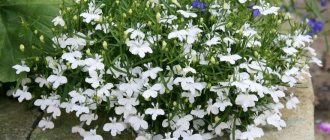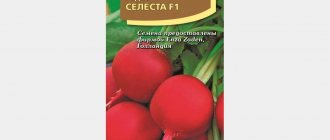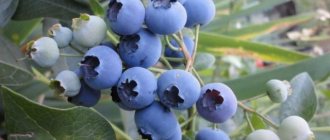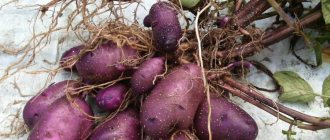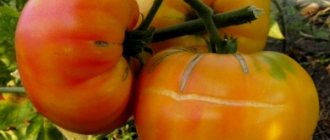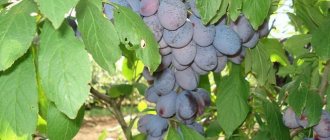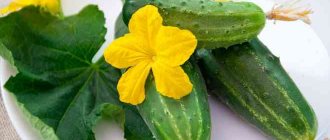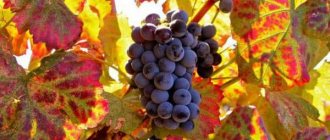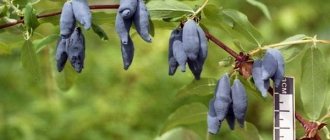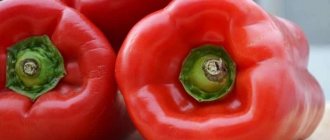Dwarf blue spruce is a miniature copy of its tall relatives. It does not take up much space on the site and fits harmoniously into the exterior at any time of the year: in summer it serves as a beautiful background for flowers, in winter it stands out in contrast against the snow-white snow.
The popularity of “dwarfs” among coniferous plants for landscape design is due to their decorative appearance due to the unusual colors of the needles, the lack of the need to spend a lot of time caring for seedlings, combined with the high frost resistance of most varieties. The main thing is to study what adult plants of different varietal varieties look like in order to choose an option that can be combined with other garden plantings in a particular area.
Argentea Pendula (Argentea Pendula)
The conical shape of the crown of this variety has one peculiarity: the branches densely cover the trunk, but the lower tiers are of the “weeping” type (stretch to the ground). At the age of 10, the height of the blue spruce reaches 1.5-2 m with a width at the bottom of about 1 m. The annual growth ranges from 15-30 cm.
Related article:
How to grow thuja from a branch
Blue needles reach a length of 40 mm. Elongated cones grow vertically upward and change color from purple-red to brown. For Argentea Pendula you need to choose a sunny place, protected from gusts of wind. It easily tolerates frost and any air pollution, but does not like clay soils.
Planting cuttings
The method of growing a new tree from a branch of a variety you like is considered even simpler than growing from seeds. Branches of mature spruce trees collected from the top in spring are suitable. Clean the cuttings from needles and soak in a manganese solution. Next, the procedure is similar to planting seeds: a hole is dug, drainage is laid. You must first sprinkle the twig with soil and add sand on top.
Water generously and cover the cutting with film or burlap. To speed up growth, water the cuttings four times a day. In winter, cover the cuttings with sawdust.
Blaukissen (Blue Kiss)
A dwarf evergreen shrub with a dense oval or spherical crown, formed from short, densely branched shoots. With an annual growth of about 2.5 cm, a 10-year-old specimen does not exceed 60 cm in height and 80 cm in width. The short, prickly needles remain blue-gray throughout the year; young growth is characterized by a creamy-yellow color. Spruce trees of this variety are suitable for growing in partial shade or sun, the main thing is to provide nutrient-rich soil, good drainage and the absence of standing water.
Related article:
How to trim thuja correctly
Planting and care
Several methods are known for growing these coniferous trees. They can be propagated by seeds and cuttings, as well as seedlings. This procedure is not particularly difficult, but the trees grow beautifully. However, you still can’t do without some technologies.
Seeds as planting material
If you use this planting technique, then the cones from a certain type of spruce must be taken in winter.
You can plant seeds of blue spruce varieties such as Misty Blue, Waldburn, Bialobok and many others. The collected cones should be stored in a warm place until they open, after which the seeds are taken out of them, which should be buried in damp sand and kept in this state in the refrigerator until spring.
Before planting, the material should be treated with a weak solution of potassium permanganate and placed in previously prepared soil consisting of soil and peat. The planting depth should not exceed 1-1.5 cm; the soil must be watered regularly over the next 3 weeks. After the seedlings have sprouted, they need to be thinned out.
At the future site for planting trees, it is necessary to dig shallow holes, maintaining a distance of about 25 cm between them, and drainage must be placed at the bottom. The seedlings must be placed in the center of the hole and sprinkled with soil acidified with ammonium nitrate. They must be replanted the second time in the third year after planting, keeping a distance of 1 m between them.
Planting cuttings
These varieties of spruce can be grown from twigs. The planting technique is much simpler than when using seeds. To do this, you need to cut a branch from the top of an adult plant around mid-spring. Such cuttings should be cleared of needles from below and also soaked in a manganese solution. After this, the procedure is repeated:
- A hole is dug.
- Drainage is placed at the bottom.
- The branch is sprinkled with earth taken from under a coniferous tree.
- Covered with sand on top.
- Waters well.
- Film and burlap are placed over the branch.
Until the plant takes root, it should be watered about four times a day. Before the onset of cold weather, the branch must be covered with sawdust.
Planting seedlings
This method can be used to plant any type of spruce. For example, Glauca spruce is grown as seedlings. Quite often before the New Year holidays, this tree can be found on store shelves, planted in a pot. This planting material makes it possible to grow a beautiful and strong tree in a fairly short time.
A seedling from a pot is also transplanted into a hole with a prepared drainage system and acidified soil. Transplantation should be carried out in such a way that the root collar of the plant is located exactly at the same level as in the tub. You should not deepen it excessively: the process of rotting may begin. If, on the contrary, you place it too close to the surface, it can dry out extremely quickly.
Immediately after planting and for some time after that, the plant needs to create shade. Of course, this tree will subsequently have to be cared for: watering, fertilizing, pruning.
Echiniformis (Echinoformis)
A small blue spruce with a dense crown in the form of a hemisphere, which with age, in the absence of pruning, spreads to the sides and becomes cushion-shaped. Grafting onto a low standard allows you to get an almost regular-shaped ball. Even at 30 years of age, the height does not exceed 0.6 m, the crown reaches a diameter of 1 m.
Related article:
Low spruce trees for the garden
Echiniformis is characterized by short (up to 2 cm) shoots growing radially from the center of the bush, narrow bluish-green needles 5-7 mm long and the absence of cones. When growing, the nutritional value and lightness of the soil are important; compaction and waterlogging will be detrimental, but in general, Echinoformis is unpretentious compared to other dwarf relatives.
Preparing blue spruce for winter
Almost all varieties of blue spruce are frost-resistant. It is necessary to prepare for winter if you have young trees and low-growing varieties. It is necessary to press the branches against the tree trunk to prevent them from being broken by the snow mass.
Using blue spruces as ornamentals is an inexpensive alternative to other ornamental trees. Spruce trees fit perfectly into landscape design and can be planted either in whole groups or individually. Some varieties look great as hedges.
If you intend to grow blue spruce yourself, difficulties will arise only at the initial stage of cultivation. In the future, blue spruce trees do not require careful care and only need to be treated with fungicides and insecticides to protect them from fungal diseases and insects.
While watching the video you will learn about growing blue spruce.
To summarize, we can say that blue spruce is a spectacular and unpretentious plant ideal for growing in Russian climatic conditions. It’s definitely worth planting a couple of such trees on your country plot, because by planting blue spruce on your plot you emphasize the sophistication and sophistication of your garden.
Edith (Edith)
A low variety with an almost ideal conical crown shape, characterized by increased density due to thin needles growing densely on the branches. In the first years, the blue spruce develops a leader shoot, which will subsequently become the basis for the formation of a correct, even crown. By the age of 10 it grows to 1.5-2 m. Subsequent annual growth is 20-25 cm.
Small (up to 3-6 cm) cones appear on 6-8 year old specimens. In spring they are pink in color, but gradually become light brown. Edith is frost and drought resistant and can grow in polluted city air. Even light partial shade is suitable for its cultivation, but in the sun the crown will be much more luxuriant, and the needles will acquire a more saturated blue hue.
Related article:
Ideal conifers for a summer cottage: 6 best varieties of decorative spruce
Description of the species
The homeland of this species is considered to be mountainous areas in western North America, where blue spruce grows at an altitude of 1750–3000 m above sea level. These trees usually grow along the banks of rivers and streams, where the soil holds more moisture. In its natural habitat, in nature, blue spruce lives for about 300–400 years (in our latitudes its life expectancy is no more than 100 years).
The prickly blue spruce grows up to 30 m in natural conditions, but sometimes 46-meter trees are found. The trunk usually reaches 1.5 m in width. The bark of blue spruce is thin and scaly. The shape of the crown gradually changes over time: in young trees it is cone-shaped, in older trees it is cylindrical. The needles of the crown are prickly, blue, with a bluish, silver or greenish tint. The needles have 4 clearly visible edges and a length of up to 1.5–3 cm. The needles remain unchanged for about 4 years. The more blue it contains, the more valuable the variety is.
The branches of the tree are decorated with cylindrical cones of red-violet color, which, as they dry, gradually change color, lighten and, ultimately, become pale brown. They grow up to 6–11 cm in length and 2–4 cm in width. The seeds of the cones are black. Each grain is 3–4 mm in size and is equipped with a light brown wing up to 10–15 mm long.
In its natural habitat, in nature, blue spruce lives about 300–400 years.
The root system is not very deep, fibrous, sensitive to damage and dries out quickly in the open air. Nevertheless, this plant has good hardiness, resistance to strong winds, can withstand dry weather in summer and frosty winter, as well as urban conditions where the air is usually polluted by industrial enterprises and transport. Thanks to these qualities, blue spruce is well suited for landscaping in megacities. Within a few years after planting, trees can live independently, without requiring any special care.
Prickly blue spruce is resistant to soot, smoke and dust and adapts well to cities and towns. She is not afraid of strong winds, bad weather, spring frosts, dry air and summer heat. Due to its decorative properties, blue spruce is used to create landscape compositions. Different varieties of this prickly plant also have different colors and shades, which allows decorators to obtain a beautiful color palette. There are dwarf blue spruce trees with different crown shapes; they decorate balconies, rockeries and patios and gardens, where they look very harmonious.
She is not afraid of strong winds, bad weather, spring frosts, dry air and summer heat.
Frieda (Frida)
A very low-growing variety of prickly spruce. It is distinguished by a very slow growth rate (2-5 cm per year), by the age of 10 it reaches a size of 40x25 cm. The needles are characterized by a steely wax coating and a color that varies from blue-green to rich gray-blue. The dense compact crown usually has a nest-like or irregularly rounded shape and is formed from horizontal short branches. It is better to choose bright places for growing. Frida is frost-resistant, not demanding on soil quality and moisture, the main thing is to avoid waterlogging.
Blue spruce Blue Diamond (Blue Diamond, Blue Diamond)
A medium-sized, fairly young variety of prickly spruce of American selection. The height of an adult tree reaches 6-9 m, the crown diameter is about 4-6 m.
The crown is wide-conical, dense, lush. The trunk is slender, the branches form regular dense tiers around the trunk from the very ground to the very top. The plant does not need shaping.
The needles are thin, tender, dense, blue in color. The cones are elongated, brown.
The variety prefers sunny, open, but windless places, drained slightly acidic fertile soil, although if necessary it will grow in others. Does not tolerate excessive soil moisture and stagnant water. It has high winter hardiness and tolerates late frosts and drought well. Propagates well by cuttings, slow growing.
Glauca Globosa (Glauca Globosa)
A classic representative of the low blue spruce family. The crown can be spherical, cone-shaped (including with a wide base) or asymmetrical. Moreover, in the first years it resembles a loose, sometimes one-sided ball. Only by the age of 10 does a leader shoot appear with more active growth, serving as the basis for a more elongated crown. You can also maintain its spherical shape through regular pruning.
Related article:
Which junipers have blue needles
Glauca Globosa is characterized by a slow growth rate, in 10 years it grows up to 1 m. The maximum possible height is 2-3 m. The dense needles are quite hard and prickly, silver-blue in color, but on young shoots the needles are light blue. Male cones are brown-brown in color, while female cones change shade from red to green and light brown as they ripen. Representatives of this variety successfully cope with air pollution, which allows them to be planted in urban environments.
Meaning and application in landscape design
In Russia they are used exclusively for decorative purposes. This can be confirmed by at least growing Bonsai spruce at home. Prickly blue spruce takes root well in urban environments, where the air is very polluted, and purifies it.
This blue spruce can be an excellent solution for the design of a garden, vegetable garden, or just a street. Depending on its shape, the plant is used to decorate flower beds or large summer cottages. Blue spruce goes well with decorative items or stones. Blue spruce will help decorate any garden and fit perfectly into any design.
Glauca Pendula (Glauca Pendula)
The unusualness of the spruce lies in the weeping shape of the crown, as evidenced by the word “Pendula” in the name of the variety. Densely spaced hanging branches create a cascade effect, with the lower tiers actually resting on the ground. There is no trunk as such, but any powerful shoot that is tied to a support can play its role. The densely spaced blue needles retain their color throughout the season; in open sunny areas you can observe its brighter shade.
Related article:
Beautiful low-growing spruce trees for the garden
The height of the tree is regulated by the level of garter and grafting, which allows you to obtain specimens of a wide variety of sizes, shapes and crown contours. Usually, in small areas, the tree is formed up to 3-5 m. With low grafting and the absence of a garter, Glauka Pendula can replace a ground cover plant. The variety is resistant to smoke and soot and tolerates drought better than its other relatives.
Signs of spruce (Picea)
The needles are tetrahedral or flat with keels, sit on a raised surface (a fold of the bark) and for some reason are turned upside down. The cone is hanging, ripens in the fall and, having opened its scales, pours out its treasures. The bark is brownish-gray, fairly smooth, thin, cracking into pieces, and resin oozes along it.
Spruce bark
Prickly spruce
Prickly spruce (P. pungens) is truly thorny. Its branches bristle with hard, pointed needles 2-3 cm long. The cone is the same shape as that of a regular spruce, but somewhat smaller, and its scales are lighter, thinner and wavy. Inhabits the western US states of Colorado and Wyoming.
The blue form of this spruce occupies post No. 1 in our country - near the walls of the Moscow Kremlin. In general, this spruce is the most common in urban landscaping. The squares and boulevards of many cities (especially the front ones, near government buildings) are decorated with orderly rows of blue pyramids. The dominance of these purebred American women in strategically important places is not ideological sabotage at all. Their mission is exclusively humane. The fact is that prickly spruce is very resistant to urban conditions: gas pollution, pollution and soil compaction, and no one can entrust it with such dangerous tasks for conifers as landscaping streets and squares.
Prickly spruce, variety 'Koster'
Prickly spruce was introduced into cultivation in 1862, and since then, nurseries in different countries have been breeding geometrically correct and unpretentious pyramid varieties for urban landscaping and selecting all sorts of oddities for private owners. The blue uniform receives special attention.
Of the more or less large "urban" varieties, one can name 'Hoto' , which takes cuttings well; 'Hoopsii' – very blue, but does not take cuttings well; popular – 'Koster' . Other varieties in this group are 'Oldenburg' , 'Omega' , 'Moerheimii' , 'Snowkist' , 'Thomsen' .
Prickly spruce, variety 'Hoopsii'
Of the original low forms, we often sell 'Glauca Globosa' - a “slow” variety with a flattened shape. The rest are for some reason more rare, although many of them have been bred. Among them: 'Montgomery' - with a crown shape in the form of a regular hemisphere with a central leader; 'Gloria' , 'Jean Iseli' , 'St. Mary' , 'Thume' – with shapeless crown; 'Furst Bismarck' – with spreading branches and strongly blue needles; 'Glauca Prostrata' – with an outstretched crown in the shape of a wave; 'Glauca Procumbens' – with a creeping crown; 'Glauca Pendula' – with irregular hanging branches; 'Blue Totem' and 'Iseli Fastigiate' - with branches sticking up, forming a narrow crown, like a tongue of flame; 'Copeland' – with a weak, crooked, wind-beaten, pyramid-shaped crown; 'Fat Albert' is a very thorny, pugnacious variety with good growth.
Engelman spruce
Engelmann spruce (P. engelmannii) is similar to its fellow countryman, prickly spruce. It is distinguished by pubescent young shoots, softer needles and small cones. Despite its wide natural range, it is cultivated much less frequently and has few decorative forms. It is an industrial tree for producing wood and resin. However, sometimes its blue form is also grown.
Canadian spruce, or blue spruce
Canadian spruce , also known as blue spruce (P. glauca). Permanent residence - Canada and northern USA. A dense crown, bluish leaves and a small (3.5-5 cm) cone with thin wavy rounded scales immediately distinguish it from the common spruce. In nature it has both bluish-green and blue forms.
Canadian spruce, variety 'Blue Wonder'
Its dwarf varieties have become widespread. 'Alberta Blue' is a mutation of the famous variety 'Conica' . 'Arneson's Blue Variegated' - the same, but only individual branches turn blue, prone to reversions. 'Blue Wonder' and 'Sanders Blue' are small pyramids. 'Blue Planet' is a dense ball with protruding branches, in other words, a hedgehog. 'Coerulea' is a silvery, slow-growing variety, but has a fir-tree shape. In these varieties the blue tint is most pronounced, but many others have it to one degree or another as a species characteristic, i.e. a characteristic characteristic of this spruce by nature.
Black spruce
Black spruce (P. mariana) from Canada and northern USA. A very slender tree with thin hanging branches and an irregular crown. The needles are blunt, dark with a bluish tint, the light stomatal stripes are especially wide on the upper (facing the branch) side. The cones are very small (up to 3.5 cm), dark purple until ripe. Dense dwarf varieties with perfectly covered short branches have an exaggerated blue tint due to stomatal stripes, clearly visible on protruding short needles: 'Beissneri' , 'Doumettii' , 'Ericoides' , finally, 'Nana' - an old variety that includes more than one clone .
Sitka spruce
Sitka spruce (P. sitchensis) is found in western North America. Long (up to 2.5 cm) very prickly needles are flattened. On top they are silver with stomatal stripes, but the shiny bright green underside is better visible. They grow pretty dwarf varieties - witches' brooms with ruffled needles: 'Nana' , 'Papoose' , 'Renken' , 'Siberzwerg' , 'Strypemonde' .
Sitka spruce
Serbian spruce
Serbian spruce (P. omorica), which lives in the mountains of Yugoslavia, is dressed in flat needles of the same color - “day and night”, but it is not so prickly and shorter. The narrow dense spruce, beautiful in itself, has many dwarf varieties - pyramids and balls. Interesting, for example, is the shimmering 'Treblitzsch' , which shows both sides of the needles: both silver and green.
Serbian spruce
Hermann Naue
These blue spruce trees are characterized by a dense, prickly, cushion-shaped crown that turns into a wide cone with age. Over 10 years, it usually grows up to 0.7 m in height, up to 0.8-0.9 m in diameter. Representatives of the variety are characterized by the absence of a central trunk, short rigid branches of various orientations, covered with gray-blue needles.
During the fruiting period, which begins at a young age, numerous bright pink cones add to the showiness of the tree. As they dry, they take on a pale brown tint. Herman Nau tolerates summer drought and winter frosts well.
Related article:
Thuja turned yellow after winter - what to do, how to help the plant, video
The best varieties of blue spruce: a true decoration for your garden
Blue spruce or prickly spruce is a modern decoration loved by many gardeners and landscape designers. Its unique appearance, often symmetrical crown, ease of care and high frost resistance have made it popular not only in Europe, but also in many regions of Russia. A beauty came to us from North America, where it grew mainly in mountainous areas. Thanks to breeders, many varietal varieties of blue spruce have now been developed, which are common in ornamental horticulture.
Blue spruce is versatile in use and can even become the main decoration of the New Year. It is noteworthy that prickly spruce is gas and dust resistant and that is why it can often be found in city parks and alleys as the main decor. Blue spruce seedlings do not require much time for care from their owners, and they are very decorative, thanks to their needles. The needles of this species are hard and very dense, often silver-blue in color. The needles are given such an unusual coloring by a thick layer of wax that entwines each needle. This is a kind of adaptation of the blue herringbone to environmental influences.
The crown shape of blue spruces can be pyramidal, cone-shaped, or even in the form of dwarf hemispheres or balls. It is the shape of the habit that determines the further role of blue spruce in landscape design. After all, no matter where you decide to plant the seedling - alone or in a composition - it will always attract attention and add emphasis to the landscape. For example, the prickly spruce “Edith” of medium height, with a symmetrical, “regular”, pyramidal crown, is capable of majestically decorating empty areas or becoming a living New Year tree. Its needles are silver-blue and short. Against this background, various types of lights or New Year's toys look great.
An excellent alternative, if you decide to buy a Christmas tree for your plot, would be the popular “Hoopsie”, which is considered the most elegant blue beauty. It grows up to 8 meters in height, but has a moderate growth rate and will delight with its decorative qualities for many years. The unpretentious, lush and chic blue spruce “Hoopsie”, although it costs more than, for example, the “Glauka” form, but lives up to all the wildest expectations of its owners.
Another blue spruce variety that is impossible to pass by is Blue Mountain. A real “giant” among its relatives, it grows in the wild to about 20 meters in height and 10 in width. It has tough, fairly long needles of a bright blue color. Thanks to these characteristics, it got its name “blue mountain”. It has a fast growth rate and the best resistance to drought among blue spruces. The Blue Mountain spruce looks great in an alley planting, as well as planted alone against the backdrop of outbuildings or a lawn.
No less common in urban plantings are blue spruce varieties such as “Misty Blue” and “Fat Albert”. Both of them adapt well to new planting conditions and have high frost resistance. The first variety is translated as “White Fog” and fully lives up to its name, as it has spectacular blue needles, which become lighter with age. If you look at the alley of planted Misty Blues, you get the impression that the seedlings are shrouded in a light fog. “Fat Albert” is more often used for growing in private areas, since, unlike Misty Blue, it grows up to 5 meters, that is, much more compact (in comparison, Misty Blue is up to 15 meters). Just like its predecessor, Fat Alber is decorative, thanks to its symmetrical pyramidal crown and the very impressive silver-blue color of the needles. A feature of the latter is the ability to achieve green color in the needles in the shade.
Prickly spruce "Blue Diamond" is a relatively new variety, bred in 1990 in North America. A distinctive feature of Blue Diamond is its not so hard, thin needles of sky blue color. It is also famous for its even, regular crown and slow growth. The branches fit tightly to each other, forming a pyramidal, wide-conical shape. Blue spruce is very lush and looks beautiful both alone and in a group with other beautifully flowering or dark green representatives.
Prickly spruce “Bialobok” is a unique variety of small fir tree, reaching only 2 meters in height. Such a beauty will become an indispensable element in the composition and rocky gardens. It has hard silver-blue needles and a hemispherical crown shape. The undeniable advantage of blue spruce is the spring young growths of creamy-yellow needles that stand out against the heavenly color of old needles. Biolobok has brownish-brown or red cones that are also very decorative. Many who come to our garden center personally note the high decorativeness of the seedlings and their unique “zest”.
Prickly spruce “Glauka Globoza” is very loved by domestic landscape designers. Compact, light and neat, growing up to 1 meter, it proudly deserves a place in the front row of the composition or decorates the entrance area. There are also representatives who are grafted onto a standard and it truly looks great - try it from personal experience! Caring for the baby is not difficult and a complete pleasure.
Prickly spruce "Glauka Pendula" is a weeping form of the previous spruce. Thanks to its branches drooping to the ground, which are slightly raised up at the tips, it creates an amazing fairy-tale landscape. The needles, like other representatives, shimmer in all shades of sky blue. It is often an accent element in compositions with other plants or planted against a background of pebbles.
Prickly spruce "Kebab" - unlike everyone else, with an asymmetrical crown, lush and dense. All this clearly fits the description of the magnificent blue spruce "Kabab". It grows up to 10 meters in height and has tightly pressed branches that give the tree its uniqueness. But this variety also has another feature - the needles of Kaybab are crescent-shaped and silver-blue in color - like diamonds shimmer in the sun.
Prickly spruce “Koster” is a beautiful tree with a neat pyramidal crown. Grows up to 7 meters in height and approximately 4 meters in diameter. The branches are directed horizontally and are completely strewn with prickly needles of a soft blue color. The fire was bred on the basis of genetically heterogeneous material, so it will require close attention in its care, especially in the first years of planting. Do not overwater the seedlings, monitor their health and constantly feed them with fertilizers. In return, the prickly spruce “Koster” will give you year-round decorativeness and a healthy, well-groomed appearance.
Prickly spruce “Super Blue Seedling” is a bright representative of prickly spruce, as it has heavenly colored needles that can darken with age. Thanks to this property, this variety has won a huge number of awards in landscape competitions. The crown is regular, conical, with a dense structure. This gives the plants volume and splendor - indispensable qualities for Christmas trees.
Prickly spruce "Khoto" is an equally lush and dense cone-shaped tree. It grows up to 2 meters in height and approximately 1.5 meters in diameter. At a young age, seedlings are characterized by slow growth, and as time passes they gain momentum. The needles are a bright, rich blue color, very saturated. Young growths are lighter, which creates the effect of the entire Christmas tree shimmering in the sun. Such a beauty will fit into absolutely any group of plants, delighting its owners all year round.
Prickly spruce "Erich Frahm" is a less popular, unlike others, but no less beautiful fir-tree of greenish-blue color.
At a young age, in this variety the shoots on one side are slightly shorter in length than the shoots on the other. This is due to the slight curvature of the trunk itself. But with age, this “flaw” turns into Erich Frahm’s “highlight”. The Christmas tree takes on a clear shape with branches tightly pressed to the trunk. The color of young needles is significantly different from old growths, standing out with an ashen tint. Prickly spruce Erich Frahm will be a pleasant addition to your garden, no matter what style it is. If your eye falls on blue spruce, buying seedlings will not be difficult, because our catalog contains numerous varieties of prickly spruce that will help you realize your wildest ideas.
Montgomery
A slow-growing variety with an annual growth of 5-6 cm. An adult spruce can grow up to 2-3 m with a diameter of up to 2 m. Silver-blue needles reach 20 mm in length, acquiring a more saturated blue color with age. Young plants are characterized by a spherical crown shape, which over time stretches vertically and becomes a wide cone, sometimes several crowns are formed. You can get it thicker and give it the desired shape through regular haircuts, which is recommended until mid-summer. Montgomery is a shade-tolerant coniferous plant, but in a sunny place you can achieve a denser crown and a brighter color of young needles.
Why are they blue?
They are usually green, but some species of spruce and pseudo-hemlock have blue forms that are occasionally found in nature. They are especially welcome in ornamental gardening. And certain types of fir can boast a bluish color as a characteristic feature. This shade gives the needles an excess layer of wax, which always covers it to one degree or another. In some cases, this sign is due to light stripes - places where stomata (breathing holes) accumulate, which stretch along the needle.
Read also: What variety of pears is good?
Prickly spruce, variety 'Glauca Globosa'
Which color is considered blue is a personal matter. Botanical descriptions include the following forms:
- glauca - gray,
- coerulea - blue,
- argentea – silvery.
But there are no clear boundaries between them. Most varieties of spruce that we call blue or even silver spruce are derived from forms called glauca in Latin.
Niemetz (German)
Decorative blue spruce with a cone-shaped crown. Characterized by an average growth rate. Reaches a height of 1 m and a girth of 0.7-0.8 m after 10 years. Young needles, appearing in early spring, retain a creamy-yellow hue for several weeks, and then gradually “repaint” the usual bluish-silver color for this variety, thicken and become prickly. Red female cones gradually turn green and brown as they ripen. Successful cultivation requires a sunny area, fertile, well-drained soil and weekly irrigation.
Related article:
What to do if the thuja turns red after winter
How to care for blue spruce on your property
A responsible gardener always uses drainage. A layer of crushed stone or small pebbles will prevent stagnation and rotting of the rhizome. Mulching with peat, compost or shredded tree bark is also necessary during the hot season.
How to feed Blue Spruce? It is best to feed the conifers in the spring - exclusively with mineral fertilizers and only for the first 5 years after planting. Organics are completely excluded for this plant.
The most common pests:
- spruce aphid (yellowing of needles, their falling);
- stem pests (for example, the bark beetle makes the plant dull and covered with holes);
- spruce spider mite (first a white web is observed, and then the needles fall from the tree and it darkens);
- needle-eaters (eaten buds and red-brown color).
Spraying with garlic and chamomile can be preventive measures. But when infected, the use of special insecticides is still required.
Nidiformis Kalous (Nidiformis Kalous)
Low-growing blue spruce of Czech selection with a very dense flat-topped crown resembling a ball or cube. It grows slowly, 5-10 cm per year, reaching a height of 0.5-0.7 m and a width of about 0.8 m by the age of 10. The needles are very fluffy, densely “stuffed”, and have a turquoise tint on young shoots , when mature, it acquires a more saturated color. Nidiformis Calus is highly frost-resistant, tolerates urban conditions well, can grow in a sunny area or in slight shade, but does not tolerate waterlogging.
Ruby Teardrops
The dwarf spruce variety got its name thanks to its bright red cones, which look especially contrasting against the background of bright blue needles. They appear in abundance on every branch in the spring and remain ruby in color for up to 2 months (in cool weather), after which they turn khaki and then golden brown.
Related article:
Landscaping with thujas
The annual growth of shoots is 5-10 cm. A 10-year-old plant reaches a height of 1 m, a diameter of 1.5 m. The general shape of the crown is cushion-shaped, spreading. The variety is not at all demanding on growing conditions, it is frost-resistant, but does not tolerate stagnation of moisture and soil compaction.
Diseases and pests
Young, immature trees are especially susceptible to infections in the first 2 years after planting in the ground. Also at risk are closely growing spruce trees that lack sunlight. For preventive purposes, supplements rich in microelements and copper, as well as immunostimulants, are used.
The most common fungal diseases found in blue spruce trees are:
- Schnotte - damaged needles darken and turn white in spring.
- Rust of cones or needles - pads appear filled with red spores of the fungus. They can change the color of the needles in the spring or form on the inside of the scales of cones that hang on the tree for a long time.
- Necrosis of the bark - the bark dries out, darkens and begins to peel off, and growths become visible on it.
- Tracheomycosis wilt develops when moisture accumulates in the soil against a background of low air temperature. The roots rot, the needles turn brown and fall off, and the spruce dies.
- Ulcerative cancer - damage forms on the trunk - swellings or wounds from which resin oozes.
In order to save a diseased tree, all affected parts are cut down and treated with garden varnish. A solution of a fungicidal preparation is poured under the roots of the spruce. If insects are seen gnawing on the bark and needles of plants, use Detis, Rogor and Karbofos.
Sanders Blue
The variety is popular for decorative garden decoration due to its dense crown of regular conical shape. But with age it may become slightly deformed, which can be easily corrected by trimming. Growth per year does not exceed 5-7 cm. At 10 years of age, the height varies between 0.7-1 m. 30-year-old spruce trees can grow up to 3 m with a crown diameter of up to 1.5 m.
Young needles are light blue in color; by mid-summer they unevenly turn green, which gives the trees an unusual spotted color. Mature needles become hard and sharp, retaining a faint bluish tint in winter. Sanders Blue does not tolerate drought or dense soil and is suitable for growing in sun or light partial shade. The needles fade in the sun much less than other varieties. In the complete absence of light, the needles will fade and the tree will weaken.
Related article:
Varieties of juniper with photos
Secrets of growing blue spruce trees
Spruces are undemanding plants that tolerate both direct sun and shade. Grows well in normal garden soils and is moderately drought-resistant. However, they do not tolerate close groundwater, so it is necessary to make a good drainage layer at the planting site.
Planting fir trees
When planting, the root collar is left at ground level. Immediately after planting, 100–150 g of nitroammophoska is applied under the plant. There is no need to feed the tree later.
Watering
In hot, dry summers, plantings of young spruce trees are watered once a week, 10–12 liters (1 bucket) per trunk.
Loosening and mulching
Loosening needs to be shallow, 5–7 cm. The top is mulched with a layer of peat of 5–6 cm, and after wintering the peat is not removed, but mixed with soil.
Pruning spruce trees
Large-scale pruning of spruce trees is acceptable if you use spruce plantings as a hedge. Typically, only dry and diseased branches should be cut out.
Preparing for winter
In autumn, it is advisable to cover decorative forms with spruce branches or special materials from late autumn and early spring frosts - it happens that the needles of young seedlings suffer from frost. Adult spruce trees are quite frost-resistant and do not require protection.
Waldbrunn
A slow-growing prickly spruce no higher than 0.8 m. The round, spreading crown often has a depression in the middle, which evokes associations with a bird's nest. It disappears as it grows, and the crown takes the shape of a dense, wide cone. To make it more symmetrical, it is desirable to tie the central shoot to a support.
Thickened short branches grow horizontally and, due to their density, make Waldbrun one of the leaders among dwarf varieties in terms of density and compactness of the crown. Bright blue young needles gradually become silver-gray in color, the length of thick soft needles is up to 1.5 cm. The coniferous plant loves sunny places or partial shade. In the absence of sufficient light, it may lose color brightness.
